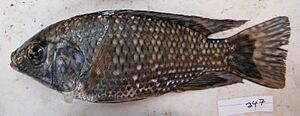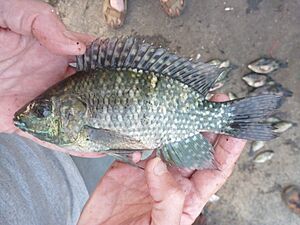Oreochromis leucostictus facts for kids
Quick facts for kids Oreochromis leucostictus |
|
|---|---|
 |
|
| Oreochromis leucostictus, male, from a fishpond near Songea, Tanzania, in 2012. | |
| Conservation status | |
| Scientific classification | |
| Synonyms | |
|
The blue-spotted tilapia (scientific name: Oreochromis leucostictus) is a type of cichlid fish. It originally comes from lakes and rivers in the DR Congo and Uganda. This fish has been moved to many other places in East Africa. Sadly, it often causes problems for other native fish species. Blue-spotted tilapias can grow up to about 36 centimeters (14 inches) long, but they are usually smaller. People catch and farm this fish for food.
Contents
What Does the Blue-Spotted Tilapia Look Like?
The blue-spotted tilapia has a deep body and a fairly small mouth. Its head is narrow and rounded, and its back is high.
Young Fish Appearance
Young blue-spotted tilapias are pale with light and dark shading. They have about 8 faint dark bars on their sides, below the dorsal fin. Other bars can be seen on their head and tail. Their fins have light spots. There's also a faint dark "tilapia mark" near the base of the soft dorsal fin.
Adult Fish Appearance
Adults, both male and female, have white spots on their sides and fins. Mature males are very dark, almost black. They sometimes have a blue-green shimmer, and their white spots stand out a lot. Their eyes are bright yellow with a dark line across them.
Mature males have long, thin tips on their dorsal and anal fins. However, their jaws do not get bigger, unlike some other tilapia species. Young fish have many small, pointed teeth. As they grow, their teeth become stronger. They usually have 4 to 6 rows of teeth, sometimes up to 8 in larger fish.
The dorsal fin has 15 to 18 spines and 11 to 13 soft rays. The anal fin usually has 3 spines and 9 to 11 soft rays. This fish has 28 to 31 scales along its side. In Lake Victoria, adults can grow to about 28–30 cm (11–12 inches). However, in smaller bodies of water, they become ready to reproduce when they are much smaller, sometimes as tiny as 8 cm (3 inches).
Blue-Spotted Tilapia Behaviour and Life Cycle
The blue-spotted tilapia is a typical mouthbrooding cichlid. This means the mother carries her eggs and young in her mouth. This is common for all known fish in its genus.
Reproduction and Nesting
During the breeding season, male tilapias become brightly colored. They claim areas over sand or mud. Here, they build a special structure called a "bower" to attract females. For this species, the bower is a simple round pit. Males dig these pits in water less than 60 cm (2 feet) deep, especially along the edges of Lake Victoria.
Females visit the males' bowers. They lay their eggs, and then immediately pick them up with their mouths. The mother keeps the young fish in her mouth until they are old enough to find food on their own. Like most other fish in this group, the mother probably protects her young. She will gather them back into her mouth at night or if they are in danger.
Habitat and Diet
Blue-spotted tilapias prefer shallow areas with lots of plants. These include lagoons and bays around the edges of larger lakes. They naturally live alongside the Nile tilapia, Oreochromis niloticus. Nile tilapias prefer deeper waters, so the two species seem to have different preferred living spaces. Blue-spotted tilapias mainly eat things from the bottom, like tiny plants and cyanobacteria. They also eat small invertebrates (animals without backbones).
Where Do Blue-Spotted Tilapias Live?
This fish naturally lives in the areas around Lake Edward, Lake George, and Lake Albert. These lakes are found in Uganda and eastern Democratic Republic of Congo.
Introductions and Impact
In the 1950s, the blue-spotted tilapia was brought to Lake Victoria. It is now very common there. It has largely replaced the native Oreochromis variabilis, though some of these native fish still live around rocky islands. Later, it was introduced to Lake Naivasha in Kenya. There, it mixed with and then replaced the native Kenyan fish called Oreochromis spilurus nigra.
More introductions have happened in Kenya. Studies show that O. leucostictus has started to mix with native O. niloticus populations in places like Lake Baringo and the hot springs near Lake Bogoria. This species has also been spread widely in Tanzania. This likely happened because it was mixed in with Nile tilapia that were moved for fish farming or to improve fishing. In Tanzania, these wild populations are growing. They are also mixing with native species like Oreochromis urolepis.
Why Are Blue-Spotted Tilapias a Problem?
People catch and farm this fish in many places. However, in fish ponds, they become ready to reproduce when they are very small. This is not good for commercial fish farming. Ponds quickly fill up with many small fish that are not worth much money. This trait probably helps the fish survive in shallow areas. If they get cut off in pools that might dry up, smaller fish are less likely to be eaten by predators like birds.
It is a problem that this species has been spread so widely. It tends to mix with native Oreochromis species. This leads to genetic mixing and creates "hybrid swarms," which are groups of mixed-breed fish. Sometimes, these hybrids completely replace the native species. This means the blue-spotted tilapia can be a threat to biodiversity. It especially harms the natural genetic diversity of tilapias, which are an important food fish in warm parts of the world.



